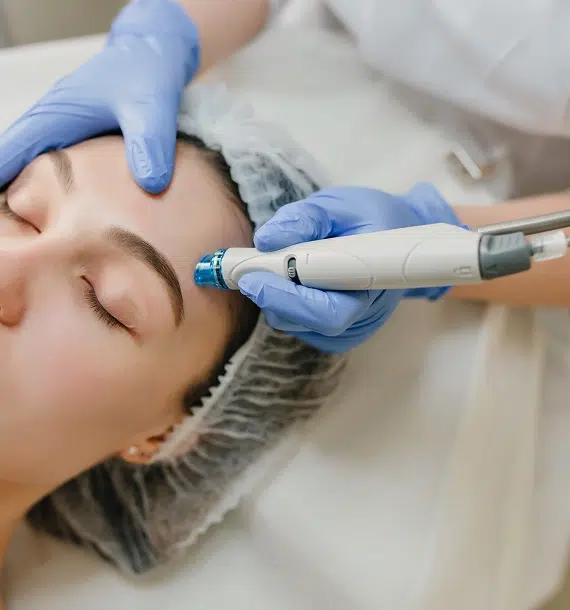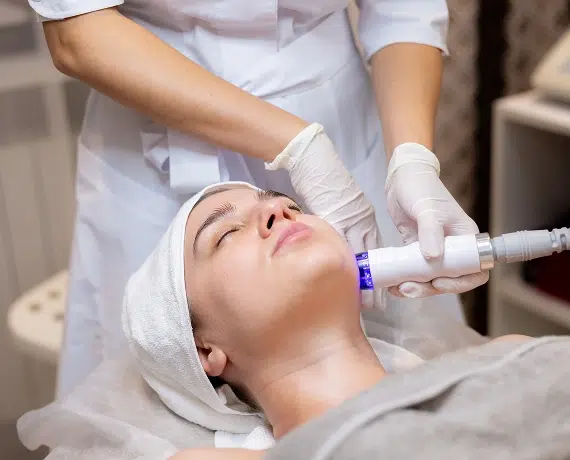A modern approach to skin and hair appearance, inspired by regenerative science.
What is Exosome Therapy?
Imagine giving your skin a refresh that works with how your body naturally functions. At Parfaire Medical Aesthetics, we offer exosome therapy—a topical application made with billions of stem cell-derived exosomes along with growth factors, peptides, vitamins, and other nutrients. This lightweight blend is designed to support the look and feel of your skin.
Exosomes are tiny messengers that help cells communicate. In cosmetic settings, they’re used to support smoother-looking skin, a more hydrated appearance, and fuller-looking hair. Many of our clients choose this non-invasive option as part of their overall aesthetic routine.


Why Clients Choose Exosome Therapy
Exosome therapy offers a forward-thinking approach to aesthetic care, designed to support the skin’s natural functions and overall appearance. Clients turn to this treatment for its innovative formulation and science-driven potential:
- Highly Concentrated: Each application includes billions of exosomes paired with growth factors, peptides, and nutrients, delivering a rich, skin-supportive experience.
- Fast-Absorbing Formula: This lightweight complex is designed for efficient absorption, helping key ingredients reach the skin’s surface layers quickly.
- Supports Visible Improvement:Often used by those looking to improve the look of fine lines, uneven tone, or hair fullness as part of their aesthetic goals.
- Non-Invasive Experience: No surgery, no extended downtime. Just a topical application that fits easily into your skincare or hair care routine.
- Multi-Purpose Use: Commonly paired with microneedling, lasers, or other aesthetic treatments to help support post-procedure skin appearance.
- Science-Inspired Innovation: Developed using the latest advancements in regenerative aesthetics and cell-to-cell communication research.
How is Exosome Therapy Used?
Exosome therapy is applied topically and used in cosmetic routines focused on the skin, hair, and scalp.
Skin Use
- Smoother Appearance: Often applied in areas where clients are focusing on fine lines or uneven texture.
- Refreshed Look: Used by those interested in a more lifted or firm appearance.
- Tone & Glow: Included in regimens aimed at brightening or balancing overall skin tone.
- Hydrated Feel: Paired with skincare routines that focus on maintaining a soft, dewy complexion.
- Texture Focus: Used when clients want to smooth out the look of surface roughness.


Hair & Scalp Use
- Hair Appearance: Chosen by clients who want to enhance how their hair looks in terms of fullness or volume.
- Scalp Care: Sometimes included in routines that focus on improving the look of the
- Hair Routine Add-On: Used alongside other non-invasive services that support the appearance of fuller hair.
Can Exosome Therapy Be Combined with Other Treatments?
Yes, many clients at Parfaire Medical Aesthetics choose to pair exosome therapy with other cosmetic services.
- Microneedling + Exosomes: Microneedling opens tiny channels in the skin, and exosomes are applied right after to pair with the treatment.
- Laser + Exosomes: Exosomes are often applied after laser sessions to fit into post-treatment skincare routines.
- PRP + Exosomes: Some clients combine PRP and exosomes in one visit as part of their skin or hair care plan.
- HydraFacial + Exosomes: After cleansing and exfoliation, exosomes can be added for an extra step in the visit.
- Exosome Serums at Home: Some clients use exosome-infused skincare between visits to stay consistent with their routine.


How Is Exosome Therapy Different from PRP?
Exosome therapy and Platelet-Rich Plasma (PRP) are both used in aesthetic settings, but they differ in how they’re prepared and applied.
- Source: PRP is created from your own blood and involves extracting and concentrating platelets. Exosome therapy uses lab-derived extracellular vesicles (tiny particles that help support how skin cells function and interact).
- Preparation: PRP requires a blood draw and processing before use. Exosomes come ready to apply and do not require any extraction procedure.
- Consistency: PRP outcomes can vary based on individual platelet quality. Exosomes are standardized and lab-prepared for uniform application.
- Use in Practice: Both PRP and exosomes are incorporated into cosmetic routines focused on skin and hair appearance.
- Experience: Clients who prefer a needle-free option may choose exosome therapy, while others may include PRP as part of their plan.
At Parfaire, we offer both services and help you decide which option aligns best with your aesthetic preferences.
Exosome Therapy
Frequently Asked Questions
What is exosome therapy?
How is it applied?
It is typically applied topically during or after other cosmetic procedures, such as microneedling, lasers, or facials. It can also be used on the scalp in certain hair-focused treatments.
How many sessions do most clients book?
The number of sessions varies. Some clients include exosome therapy in a series of cosmetic appointments, depending on their personal goals and provider recommendations.
Is there any downtime?
There is no downtime specifically associated with exosome application. However, if it’s paired with other procedures like microneedling or laser treatments, those services may involve recovery time.
Can it be used at home?
Some skincare products contain exosome-infused formulas for at-home use. These are typically recommended as part of a professional skincare plan.
Is exosome therapy FDA-approved?
No. Exosome therapy is not FDA-approved for anti-aging or aesthetic use and is considered investigational. It is offered under professional supervision in select cosmetic settings.
What is the FDA status of exosome therapy for anti-aging?
As mentioned above, exosome therapies are considered investigational for anti-aging and aesthetic purposes, as the FDA has not yet approved them for these specific uses. However, they are used in clinical settings under professional supervision. Current research supports their potential, with studies showing exosomes enhance collagen production, reduce inflammation, and promote tissue regeneration. For example, preclinical trials and peer-reviewed studies in journals like Stem Cell Research & Therapy (2020) demonstrate improved skin elasticity and hair follicle stimulation. At Parfaire, we adhere to the highest safety standards, using rigorously tested exosome products and closely monitoring ongoing research.
Curious About Exosome Therapy?
Explore a modern, non-invasive option in cosmetic care at Parfaire Medical Aesthetics. Our experienced team is here to answer your questions and help you decide if exosome therapy fits into your personalized wellness plan.
This product is not FDA-approved and is not intended to diagnose, treat, cure, or prevent any disease. Use under the supervision of a licensed healthcare provider.
